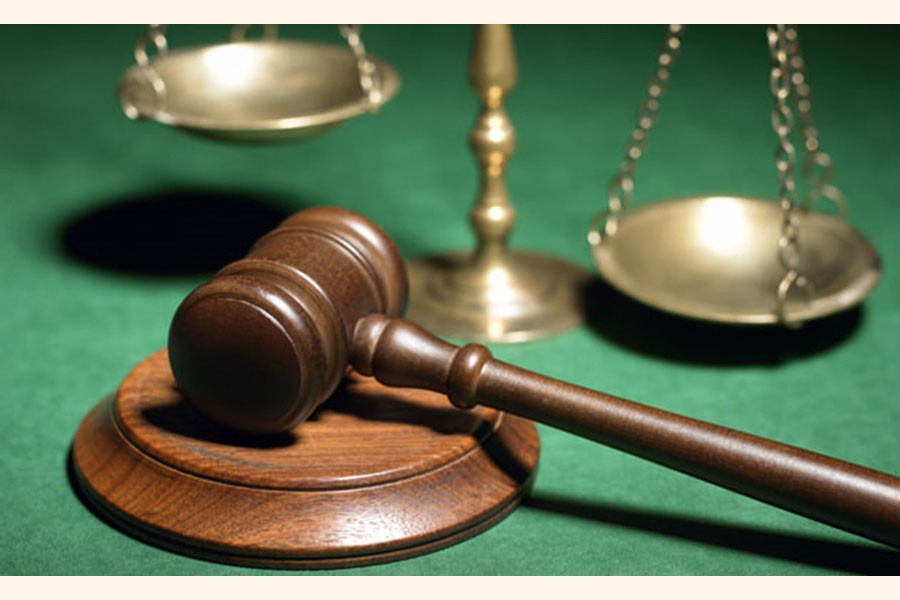The scribe had the opportunity of visiting the University of Law, Hyderabad, India. This university is widely known as NALSAR (National Academy for Legal Studies and Research). It is located at a place known as University City about 40 km away from the fast expanding and developing city Hyderabad, the capital of Telengana State of India. Of course, the purpose of the visit was to meet my granddaughter Senjuty, a first year student of the university. In front of the guest room the scribe had the opportunity of meeting the Vice Chancellor Prof Dr. Faizan Mustafa, a super gentleman and had an exchange of a few pleasant words with him.
At the entrance of the administrative building are boldly inscribed vision and mission of the university. The vision is to bridge the divide, between law and justice: support the most marginalized and excluded in their struggles and advocate the rights of all. Before making any comment, a few lines may be quoted from the book "Choosing Hammurabi Debates on Judicial Appointments", edited by Santosh Paul, Advocate of the Supreme Court of India (Page-xix).
"I have been questioned by my publisher as to why I chose this esoteric title. Why evoke the sixth king of the First Babylonian dynasty in year 2013? Why of all characters in history, choose Hammurabi, who is more known for his retributive dictum, an eye for an eye, a tooth for a tooth' which jars against any modern judicial system. I owe this explanation to the reader as much as I owe it to the publisher. The people's aspiration of what the modern judiciary should be, contrary to popular perception, finds expression in the stone and clay tablets, reveals the author's pronouncements as a ruler, to pursue justice, to punish the guilty, to protect the weak from the powerful, to protect widows and orphans, to bring fair play and order into the society, to be governed by defined laws and 'to settle all disputes, and heal all injuries". This yearning and desire of what constitutes an ideal justice delivery system is primordial. This yearning continues to this day, 4,000 years after the earliest known written legal code authored by Hammurabi.
If Hammurabi would have been present today, he would have to add one more sentence in his stone and clay tablets such as to protect the women and kids. The entire subcontinent has become filled with the skulls of women and children raped and killed at the free wills of the predators. So Hammurabi is a choice of everybody, not only of Santash Paul. How close we could be to Hammurabi during last four thousand years. Still we are yearning and yearning.
For thousands of years both law and justice have been in existence. Two in unison were likely to support the most marginalised and excluded in their struggles and advocate the rights of all. Laws have been exacted and amended, but have these been uniformly applied for all. Did the machinery for dispensation of justice have had enough strength to perform? In almost all constitutions of the world it is written that all persons, irrespective of religion, caste, creed and sex are equal before law. This song of equality reminds one of George Orwell's quotes from the book Animal Farm--"All Animals are equal but some animals are more equal than others". There is a ministry in every government known as the ministry of law. Apart from drafting and placing laws before the parliament its other functions are to vet law, and regulations framed by other ministries. But actually it moulds law and regulations to suit the purpose as to be desired by the executive and help run the tyrannical rule of the government. Of course, it is the fact that laws are applied and interpreted by courts.
The courts do not catch out law breakers. It hears only those cases brought before them by private citizens by the executive branch of the government. The enforcement of laws thereof is an administrative rather than judicial function. Proper dispensation of justice will much depend upon the transparent legislation, sincerity of the executive. In this connection it may be mentioned that in the parliamentary system of government the so-called division of the three organs of the government, executive, judiciary and legislature, sometimes becomes a misnomer. Because if a party obtains brute majority in the parliament, then executive and legislature come under the control of one leader and justice suffers from the fear of being squeezed.
The mission of the university is undertaking the activities in such a manner as to advance social justice. The term social justice has very wide ramifications. Moreover, political parties use the term absolutely with a view to hoodwinking the people, particularly during general elections. But nobody specifically defines what social justice stands for. It has been stated in the charter to ensure for the people of Bangladesh equality, human dignity and social justice. But yet social justice has not been properly defined. As a matter of fact in a society where people are divided on the basis of race, religion, caste and creed, it is difficult to ensure social justice unless the politicians come to a consensus. But in the subcontinent in most cases the politicians rather prod these issues during the election to gain political mileage.
Proper justice cannot be delivered unless the gulf of difference between law and justice is bridged. That seems to be a far cry. People around the world are clamouring for human rights and justice. We do not know if our dream will be realized or not.


